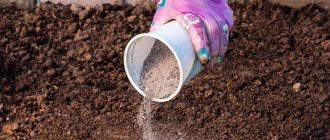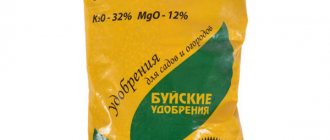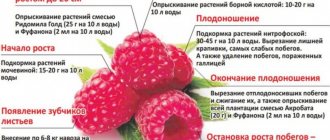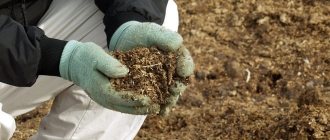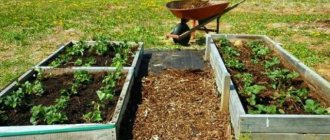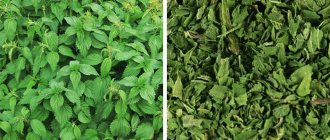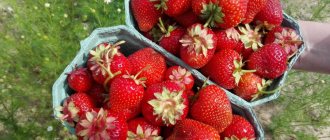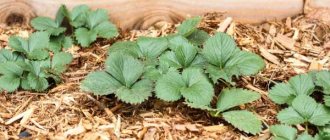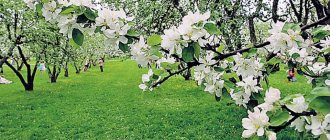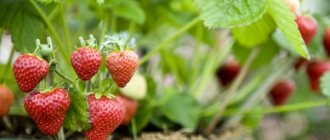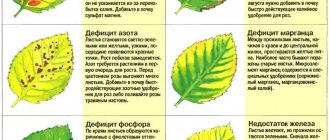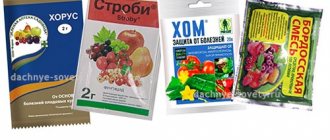The bed under the strawberries should be rich in rotted organic matter. Next, I’ll tell you what fertilizing to do to get a large harvest of large, sweet strawberries.
In addition to fertilizing, do not forget to periodically rejuvenate your plantings; remember that this crop bears full fruit in one place for a maximum of 3-4 years.
The feeding schedule is approximately this: before flowering, during flowering, during and after fruiting.
Fertilizing strawberries in spring
Waking up plants need: phosphorus (for the development of the root system), nitrogen (for increasing the mass of leaves), humates (as general natural stimulants).
Strawberry roots begin to vegetate already at air temperatures from +5 to +8 degrees. After clearing the plantation of last year's leaves, we immediately feed it.
Before unfolding the leaves, it is useful to feed the plants with urea or calcium nitrate (1 tablespoon per bucket of water). Afterwards it will be possible to provide other nutrients needed during this period for the full development of plants.
First feeding options
- infusion of chicken droppings (1:20). In order not to burn the plant, the prepared solution should stand for about three days.;
- infusion of manure (1:10) and 1 tbsp. l. sperphosphate;
- any berry OMU fertilizer (from the Gumi-Omi, Ispolin, Fertika-OMU, Buy fertilizers, etc. series);
- Fertilizer Clean sheet for strawberries according to instructions;
- Ammophos 1 tbsp. l. on a bucket of water;
- 1 tbsp. l. urea and superphosphate (per bucket of water).
My option is Calcium nitrate 10g/10l + plantofol 20-20-20 10g/10l. water, all this stuff from a watering can, one sheet at a time, so that the spine gets wet.
All fertilizing should be carried out strictly after watering , so as not to burn the roots of the plants.
After applying fertilizer, it is advisable to mulch the plantings with sawdust, pine needles, hay or inorganic mulch so that the soil under the bushes is moist. In addition, some mulch helps keep pests and weeds away.
Do not apply a lot of nitrogen fertilizers in pursuit of large berries. Sugar will be lost and the strawberries will become tasteless.
How to feed strawberries in the spring so that they bear fruit well
For active fruiting after the initial fertilization, after the appearance of the ovaries, microelements containing potassium, magnesium and calcium should be used.
- Yeast,
- Boric acid,
- Vermicompost,
- Iodine.
Among natural remedies, people often use ordinary wood ash. It contains more than 30 microelements that affect the condition of the soil. In early spring, one handful of it is applied to each bush, and then watered.
Fertilizing strawberries – “Fasco Bio”
Fusco Bio
The preparation is specifically for strawberries. The composition includes compost, ash and other trace elements. For replanting, it is enough to add about 10 grams before replanting and then use it for a larger harvest (50 grams per square meter between rows). 150-200 rubles in stores.
Hera - another fertilizer for strawberries
Humates contain potassium, nitrogen and phosphorus. Use as directed and apply in early spring.
WMD
An even more affordable and effective drug. It contains phosphorus, potassium, zinc, iron, nitrogen, magnesium, peat and others. This mineral product can be used to feed strawberries throughout the season.
Fertilizing strawberries with folk remedies
Fleur strawberry in the year of planting
- For many summer residents, nettle is considered a weed, but they have learned to use it as a good fertilizer. As it turned out, the fertilizer for strawberries is nettle, a real healing elixir for berries. Preparing fertilizing is just as simple, you need to collect more nettle bushes, place them in a container, fill them with water, if there is a possibility of rain, then press down the nettles with some weight and cover the container with a net. The nettle infusion should be mixed very well twice a day. Before starting foliar feeding, the solution is diluted with water at the rate of 1:20. Fertilizer for strawberries, nettle contains potassium and nitrogen in an easily digestible form; after watering, a large number of earthworms appear in the soil.
- Fertilizers for strawberries made from bread have a very good effect on the development of the plant; according to the experience of summer residents, it has already been proven that the berry responds very well to fertilizing with yeast. Fertilizers for strawberries from bread are prepared very simply, the dried bread is soaked in water until fermentation, ripening occurs in approximately 6-10 days. The resulting solution is diluted with water in a ratio of 1:10. Yeast creates favorable conditions for the growth of strawberries; thanks to the yeast fungus, the soil is acidified, the berry receives the necessary nutrition, thus the grain fertilizer acts as a strawberry fertilizer for large berries.
- Fermented milk products, such as whey. For strawberries, slightly acidic soil is the most beneficial environment for development and fruiting. In this regard, fertilizing strawberries with fermented milk products is a good solution to make the soil just like that. It is recommended to use fermented milk products together with ash, manure and humus. If you spray with diluted milk, you can forget about some insect pests, such as aphids and mites, for a long time.
How to properly feed strawberries, what types of fertilizers there are, their specifics
There are two types of fertilizing: root and foliar. Let's look at each of them in more detail.
Root feeding
Root feeding involves applying fertilizer under the strawberry stem or at some distance from it. They use simple and complex mineral mixtures, organic matter, and folk remedies.
Fertilizers for strawberries, which are applied directly under the root, are carefully sprinkled with a layer of soil two centimeters thick. If nutrients are scattered between rows, the digging depth is 8-10 cm.
Strawberry feeding scheme for the season
Foliar feeding
You can fertilize strawberries in the spring for a good harvest not only by the root method, but also by the leaf method. As a result of spraying the aboveground part with nutrient solutions, the plant grows faster and the ligature increases.
Foliar feeding of strawberries in spring is carried out:
- highly mobile mineral fertilizers (this group includes easily absorbed mixtures based on nitrogen, phosphorus and potassium);
- low-mobility (and these include slowly absorbed products consisting of iron, copper and boron).
In order to increase the absorption of the latter, it is necessary to spray very carefully so that the composition completely covers the entire above-ground part. It is important to spray on a dry, windless evening or cloudy day.
To prevent diseases and suppress insect attacks, foliar feeding of strawberries is combined with fungicides and insecticides. Among gardeners, the drugs Zircon, Strawberry Rescuer, Fitosporin, Actofit have gained great popularity.
Fertilizing strawberries during flowering
Strawberry Florina blossoms
The main components of feeding at this stage are potassium, boron and magnesium, as well as zinc, molybdenum, humates. Potassium improves the quality of berries, and microelements and humates gently stimulate the ovary.
Fertilizing with potassium monophosphate works well - 1 tbsp. a spoonful of powder is diluted in 10 liters of water. You can also add potassium with a solution of potassium nitrate (1 teaspoon per 10 liters) or potassium sulfate (30 grams per 1 square meter of planting).
MagBor fertilizer is also suitable for foliar feeding .
Fertilizing strawberries with ash
Preparing the infusion - pour 1 glass of ash with a liter of boiling water, leave for 24 hours. Add 9 liters of water to the concentrate, thus obtaining a ready-made working solution of 10 liters. Water the strawberries at the root.
Fertilizing strawberries with boric acid
Irrigating strawberry leaves with a solution of boric acid (1 gram per 1 liter of water) helps increase berry set. This is foliar feeding.
Spray when it is not sunny, either in the morning or evening.
Complex and mineral supplements
Complex fertilizers combine several elements that provide nutrition for the berries. As a result of their use, the bushes become powerful, tall, and the quality of the fruits improves, and their quantity will be greater. The most optimal time to apply complexes is the second mid-spring. Before feeding strawberries, the bushes are pruned after wintering, the soil is loosened, watered and covered with mulch. The most popular brands of complex fertilizers are Agricola, Fertika, Gumi-Omi. On the label, substances must be marked “for strawberries” or “for fruit crops.” The following simple fertilizers are suitable:
- ammonium nitrate. It is based on nitrogen (about 40%), which ensures intensive growth of bushes after a long winter. It can only be used in soil with a neutral reaction, since the substance can strongly acidify the soil. Adding dolomite flour or limestone will solve the problem and get rid of high acidity. Dilute tbsp. dry matter in a 10-liter bucket of water and water the strawberries under the bush with the solution once every 10-14 days until flowering;
- nitroammophoska. It contains three main elements: nitrogen and phosphorus with potassium. The ratios of chemical elements may vary from manufacturer to manufacturer, so you need to study the composition before purchasing. Nitrogen should always come first in terms of the amount of substance, followed by potassium and phosphorus. If the soil on the site is poor, then they begin to feed 2-3 weeks after opening the bed. Preparing fertilizer is simple: you need to mix tbsp. dry powder with 10 liters of water. Water the plants at the roots 1-2 times every 14 days. Fertilizing can be repeated after flowering, since the potassium contained in the composition has a beneficial effect on the fruits;
- urea. For the most part, the substance consists of nitrogen derivatives, so it is perfect for feeding in the spring. Urea has a neutral reaction, so it can be added without fear to both acidic and alkalized soil. Dilute tbsp. substances in a bucket of water and water the strawberries at the rate of 1 liter for each plant. You can feed the crop with urea before fruiting begins.
It is important to dilute any chemical product correctly, using personal protective equipment and following safety precautions. There is no need to overuse fertilizing and apply it even when the strawberries are already growing well, gaining color and looking healthy. Such signs indicate that everything is fine with the plants, and an excessive concentration of nutrients in the soil will only be harmful.
On a note! Fertilizers are applied in the morning so that all the moisture has time to go into the ground before the evening.
Fertilizing strawberries in June
Often there is a strong curvature of young leaves, the leaves begin to curl upward, old leaves have a yellow border along the edge (photo attached), and the roots become stumpy - these are plants experiencing boron starvation. To eliminate boron starvation, boron is added to the soil in the form of boric acid or borax when planting strawberries. This can be done in the spring by mixing microfertilizers with crushed soil when loosening or fine sand.
You can also add boron in June, when berries begin to form. Add boric acid or borax to the water for watering or spraying garden strawberries. Microelements are added at the rate of 5 grams per 10 liters of water. Boric acid is first dissolved in one liter of hot water and poured into the main solution.
When filling berries, do not use any nitrogen fertilizers !
Florina variety is very productive
In June you also need to fertilize with potassium . Potassium increases plant immunity to diseases and pests. Increases the content of sugars and vitamins in grown products. Feeding at the end of August and September allows you to survive the winter well. Use any fertilizer with a high potassium content. Or water the bushes with infusion of ash.
Boric acid: recipes for strawberries
The powder is sold in bags, standard packaging is 10 g. The drug is poorly soluble in water, so the liquid is heated to prepare the mixture. To begin with, dilute it in a small amount of hot water (1 liter), then add cold water to 10 liters.
On a note! To prepare fertilizers, only powdered boric acid is used. Pharmacy solutions for fertilizers are not suitable.
Recipes for foliar spraying:
- Powder (1 g) is diluted in a small amount of hot water. Add potassium permanganate (1 g), mix, add water to the full volume of 10 liters;
- The powder (2 g) is dissolved in hot water, the same amount of potassium permanganate is added. Before this, an ash infusion is prepared the day before: a glass of wood ash is poured with a liter of boiling water and left for a day. Mix the ash infusion and the prepared solution with microelements together and add to a volume of 10 liters.
Root feeding compositions:
- Two grams of powder are dissolved in a small amount of hot water. Add 10 ml of iodine, a couple of tablespoons of ash. Stir and add water to 10 liters.
- The second version of the solution is similar, only instead of iodine, a tablespoon of urea and 1-2 g of potassium permanganate are added to the composition. The amount of ash and boric acid is the same.
Feeding strawberries in the spring with ash, iodine, boric acid, and potassium permanganate is not only a top dressing, but also a preventative against fungal diseases on the crop.
The drug is not used in its pure form (embedded in the soil, dusted), only in aqueous solutions. Exceeding the amount of a component in the mixture leads to plant burns and growth retardation. Instead of help, you will get the opposite effect, so you need to be extremely careful when using it!
Fertilizing strawberries with ammonia
For the first feeding (in early May) you need 40 ml of ammonia per 10 liters of water. After fertilizing with ammonia, the strawberries need to be watered again with plain water.
The second treatment of strawberries with this product is carried out after flowering. For 10 liters of water take 3 tablespoons of ammonia. First, the strawberries need to be watered with water, then with ammonia solution. Treatment protects plants from pests. If you water the berries, then you need to wash them before using them.
The third treatment is carried out after harvesting. In this way, the bushes are prepared for wintering. The most concentrated solution is used. For 10 liters of water you need 1 bottle of ammonia and 5 drops of iodine. Plants need to be watered abundantly.
Feeding after winter with iodine and boric acid
Early spring feeding of strawberries with boric acid stimulates the formation of many flower buds. As practice shows, this technique increases yield by 70%. And the accompanying feeding of strawberries in the spring with ammonia gives a rapid increase in vegetative mass. Ammonia should be applied immediately after the snow cover melts. There is no point in waiting until the ground thaws completely. You need to stock up on several buckets of warm water (temperature 40 – 45 °). For 10 liters of water add 50 - 70 ml of ammonia. To feed strawberries after winter, 2 liters of this solution are used for each adult bush.
After 2 - 3 days, you need to add potassium superphosphate to the soil at the rate of 10 g. for each bush, after which the soil is loosened to a depth of 5 cm. The top can be mulched with well-rotted compost or last year’s sawdust.
Then we feed the strawberries with iodine, potassium permanganate and boric acid. This mixture is both a stimulator of growth and the formation of flower buds and a pest control agent against many diseases and pests. It has been noticed that feeding strawberries with iodine and potassium permanganate significantly reduces the number of weevils and completely eliminates the development of gray rot of fruits even in cold and rainy summers.
To feed strawberries with iodine and boric acid, you need to take a liter of warm water and dissolve in it 1 teaspoon of boric acid, ½ teaspoon of potassium permanganate and ½ teaspoon of a 5% alcohol solution of iodine. Mix everything well and dilute in 20 liters of warm water. This is a ready-made solution for treating bushes. It is advisable to carry out processing in 2 stages. First, use a ladle to add 500 ml of solution under each bush. Then, using a spray bottle, thoroughly spray the entire foliage mass.
Feeding with iodine and boric acid should be repeated three times before the harvest begins and twice in the fall after pruning in preparation for wintering. If everything is done correctly, the berry crop will have increased immunity, increased productivity, and the berries will become sweeter and more aromatic. Weevils and other pests disappear. The berries do not rot even in conditions of insufficient sunlight.
The video shows how to use boric acid on strawberry plantings to obtain a large harvest of aromatic and sweet berries:
Fertilizing strawberries after fruiting
it's time to transplant the "mustache" to a permanent place
Strawberries respond well to fertilizing with phosphorus and boron fertilizers.
Compost or fermented herbal infusion also works well. You can also simply use a complex water-soluble fertilizer with an equal content of nitrogen, phosphorus and potassium and necessarily with the presence of boron.
For example, “Fertika”, “Ryazanochka”, “Kristalon” and the like. Liquid complex fertilizers with the addition of humates have a good effect. Feeding with humates can be combined with protection against fungal infections using Fitosporin.
During the period of formation of flower buds of the next year (July-August), garden strawberries need to be fed at least once.
The modern market offers many special mineral fertilizers for garden strawberries. The same fertilizers, if applied in the fall, can better prepare the plant for wintering.
We recommend:
- Autumn fertika is a complex mineral fertilizer with a high content of phosphorus and potassium.
- Novofert is a universal complex fertilizer that is also suitable for strawberries.
- Potassium humate is used for garden strawberries, as a rule, twice: after fruiting and in mid-September. Fertilizer has a positive effect on the development of the root system, the formation of flower buds and the restoration of berry bushes.
When to feed strawberries in spring: timing and application pattern
Strawberries should be fertilized in the spring according to a certain scheme, so it is extremely important to know when and at what time to apply fertilizer, and it is necessary to rely on the phases of plant development.
- The first feeding of strawberries is carried out in early spring, when a stable positive temperature has established and the plant begins to awaken (new leaves begin to grow). That is, practically after you open the bushes after winter, trim them, loosen them and remove the weeds. At this point, the plant requires a lot of nitrogen to grow green mass.
- Second feeding of strawberries: just before flowering (during budding). In order for strawberries to gain weight - to be large and sweet, they need more potassium and phosphorus. Therefore, the fertilizing must necessarily include potassium and phosphorus fertilizers, as well as some nitrogen (but much less than during the first fertilizing).
- The third is during flowering and fruiting. During this period, it is recommended to use more potassium and phosphorus. Then the berry will be sweeter, stronger, and more aromatic.
- And the last one: After fruiting and harvesting (late summer-autumn). The purpose of the fourth feeding of strawberries is to ensure that the bushes lay flower buds, prepare for the next harvest, and also strengthen themselves before wintering, in other words, so that they do not freeze. This means that plants require phosphorus and potassium (optionally, superphosphate and potassium sulfate or simply potassium monophosphate).
Ava for strawberry
Long-term fertilizer for strawberries and wild strawberries. Provides acceleration of fruiting, development of a powerful root system, increasing the size of berries and improving their taste, increasing resistance to diseases, pests and adverse weather conditions.
Composition (wt.%), not less:
Phosphorus (P2O5) - 50-54%, Potassium (K2O) - 22-24%, Calcium (CaO) - 8%, Magnesium (MgO) - 3%, Silicon (Si) - 1.5%.
Trace elements: Sulfur (S), Boron (B), Iron (Fe), Manganese (Mn), Cobalt (Co), Molybdenum (Mo), Zinc (Zn), Copper (Cu), Selenium (Se).
Consumption rate : The main fertilizer is to apply 3-5 grams under the bush in the root growth zone. (5g - 1/2 teaspoon). Top dressing - add 3 g to the zone of active root growth.
The need to process strawberries
Unfortunately, there are so many pests and diseases in strawberries that it is impossible to do without periodic treatment with one or another preparation. Of course, careful care of plantations (timely weeding, watering, loosening, removing diseased plants and excess tendrils) significantly reduces the need to use “chemicals,” but from time to time adding additional substances to the soil and spraying the bushes with insecticides or “home remedies” must be done.
Main pests and diseases of strawberries
Common strawberry pests include:
- The raspberry-strawberry weevil is a widespread pest of strawberries. Grayish-black beetles, 2–3 mm in size, overwinter under old, half-rotten leaves. In spring, the beetles first feed on leaves, then the females begin laying eggs. The larvae remain inside the buds. In summer, young beetles appear;
- Strawberry (transparent) mite is a very serious pest of strawberries. Overwinters at the base of leaves. Adult mites are up to 0.25 mm long, glassy yellow. In spring, females lay eggs on young leaves, which wrinkle, become yellowish, and often dry out. Increased air humidity favors the proliferation of the pest;
- Stem nematode is widespread everywhere. Causes yield losses of up to 70%. No more than 1.5 mm in size, lives and reproduces in the tissues of the strawberry bush. Infected plants are stunted and become ugly. Peduncles thicken and bend. Heavily infected bushes bear fruit very poorly. The stem nematode is tolerant of adverse weather conditions;
- The strawberry nematode differs from the stem nematode in its smaller size (up to 1 mm). During the season it develops in 6–8 generations. In terms of resistance to unfavorable environmental conditions, it is inferior to the stem nematode. Plants infected with the strawberry nematode exhibit severe thickening and branching of some stem parts, as well as the formation of a large number of new buds. The petioles of the leaf blades lose their pubescence and acquire a lilac-red color. With severe infection, yield losses reach 30–50%;
- root weevils. The beetles are black, 4–5 mm in size, the antennae and legs are reddish-brown; The larva is white, with a brown head. Weevils damage strawberry leaves by gnawing them from the edges. They overwinter in the soil. In the spring they resume feeding and pupate in June;
- slugs They love strawberries very much and can completely destroy a juicy berry.
Photo gallery: insects that harm strawberries
Due to the activity of the strawberry mite, the leaves wrinkle and dry out.
The nematode causes deformation of berries and thickening of peduncles
The raspberry-strawberry weevil is a widespread pest of strawberries.
Slugs eat away holes in ripe berries, sometimes completely destroying the fruit
The most dangerous strawberry diseases:
- Gray mold is a very harmful disease. Dark spots of indeterminate shape form on the leaves. Brown spots first appear on the berries, then they enlarge, become covered with a gray fungal coating, rot and dry out. Ripe berries are most often affected, especially those lying on the ground without litter. The disease manifests itself in cold and damp climates, especially in dense, poorly maintained areas;
- Powdery mildew is a widespread fungal disease that affects the entire strawberry bush. A white powdery coating forms on the underside of the leaves. Sick plants become bronzed and develop poorly. Severely affected rosettes take on an ugly shape. Affected berries also become covered with a white coating and acquire a musty smell. The disease develops throughout the summer, reaching its climax by early autumn. High air humidity contributes to the disease;
- white spot affects leaves, stems, and stalks. In May, small reddish-brown round spots appear on the leaves. Severely affected young leaves die. On older leaves, the spots increase over time and become white with a reddish rim. The highest phase of the disease occurs with the beginning of flowering. Dense plantings and long-term operation of the plantation contribute to the development of the disease;
- root rot. Since mid-summer, there has been a massive die-off of the leaves of the lower tier. After 2–3 years, diseased bushes die. The entire root system is affected;
- Witch's broom is characterized by the formation of a large number of leaves, which give the strawberry the appearance of an abnormally thickened bush. The leaves are small, on thin petioles, arranged unusually straight, and light green. Peduncles are usually not formed or are without fruits. The whiskers are short and have few rosettes.
Photo gallery: strawberry diseases
Powdery mildew spreads quickly in wet weather
Light spots on the leaves with a reddish rim are a sign of white spotting Gray rot makes the berries inedible
Effective fertilizer for strawberries
Strawberries are very sensitive to nutritional deficiencies. And it is even more sensitive to the lack of nutrient balance. At all stages of its development, strawberries are demanding of phosphorus. In terms of importance, it ranks second after nitrogen. Lack of phosphorus greatly retards the development and growth of plants. Flowering and ripening are delayed, the number of fruits and flowers decreases, the yield drops sharply, and the sugar content decreases. This is why it is so important to provide phosphorus to ALL plants at all stages of development.
Fertilizer for strawberries
Some gardeners are interested in whether it is necessary to somehow feed the strawberries themselves during their development and ripening? This will be superfluous, since the berry receives all its nutrients from the stems and, if you properly and regularly feed the strawberries with roots and foliar, then the berry itself will grow excellent, juicy and tasty!
All you have to do is make sure that the berries grow clean. To do this, you need to cover the bed with strawberries with black covering material. This will prevent the berries from coming into contact with the ground and will also prevent the growth of weeds, which will allow the strawberries to receive maximum nutrients and light.
Answers to frequently asked questions
What folk remedy can increase strawberry yield?
In order to increase the yield, it is necessary to feed the crop with yeast. The yeast solution increases the size of the berries and promotes the appearance of new ovaries.
Is it possible to use chicken manure before flowering?
No, chicken manure is used in early spring. If fertilizing is applied before flowering, the buds may fall off, and all the energy of the plant will be directed to the growth of green mass and there will be no harvest. A large amount of nitrogen during the flowering period can lead to the appearance of empty flowers and the absence of ovaries.
When to use humus?
Humus for berry crops can be used in the fall. The material can be used to cover bushes. This way the plant will be protected from frost and receive all the necessary nutrients. In spring, humus is used to mulch the area. To prepare mulch, you need to mix humus and sawdust and place it between the bushes in a layer of at least 3 cm. Such mulch will not only act as a fertilizer, but will also protect the berries from spoilage.
